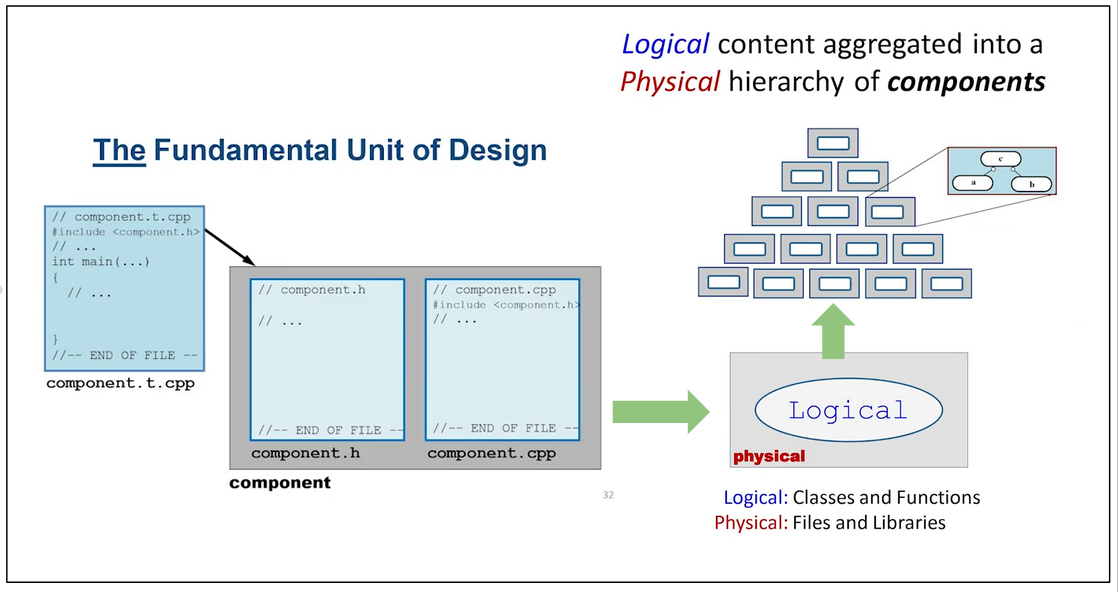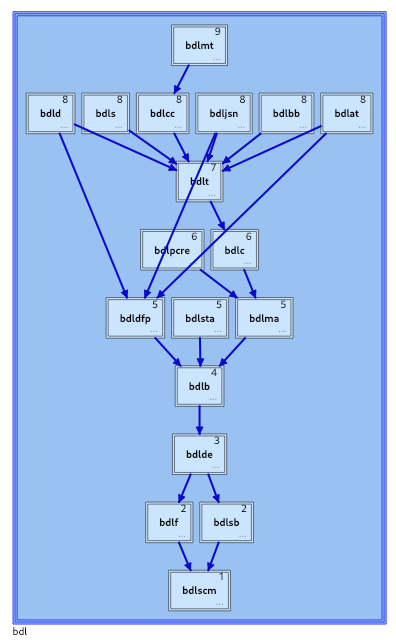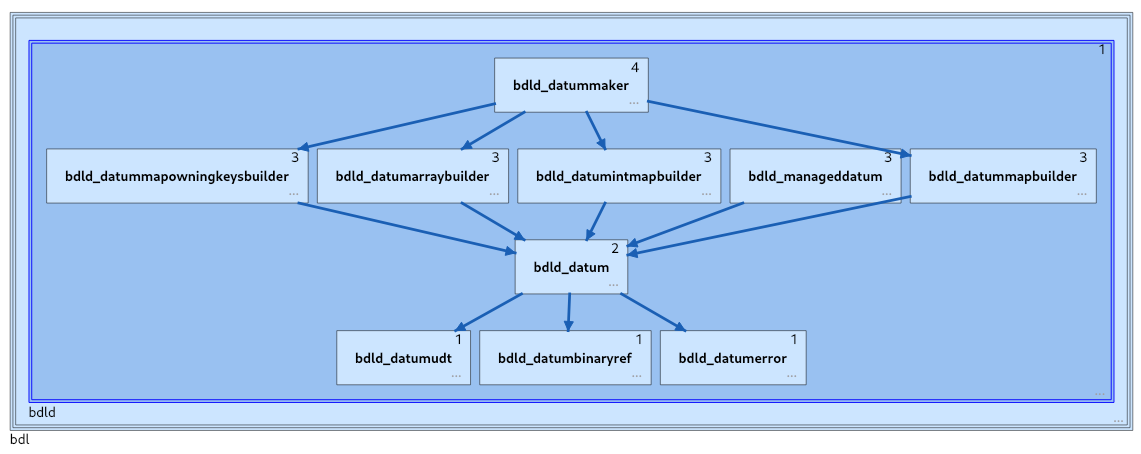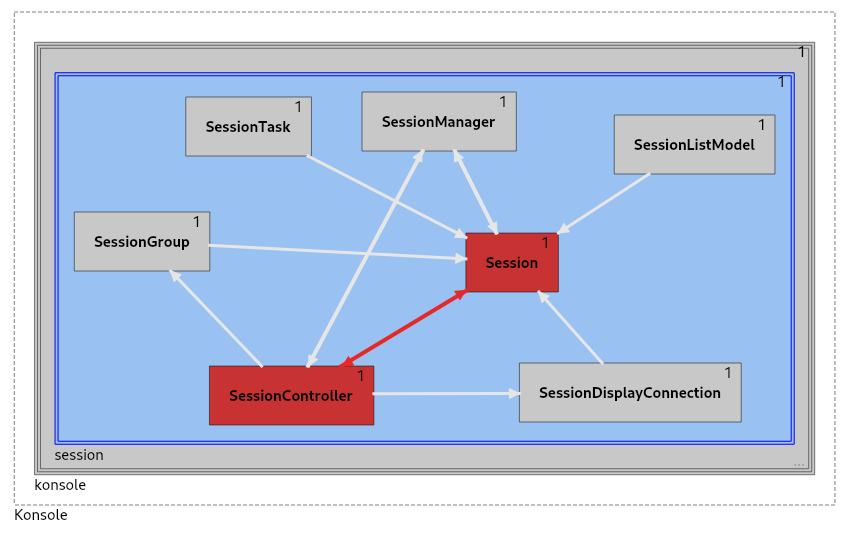
Has been a bit more than a year since I started in the Codevis project. It also has been a couple of months since my presentation on Akademy 2023, and I feel like it is time to write a bit about the software in a blog post. Tomaz Canabrava, which is also currently working in the Codevis project also started doing some writing, so you may want to check those out too.
Codevis is a software that helps you visualize your C++ codebase. It uses LLVM to scan C++ projects and generates a (relational) database representation of it. This database representation has basically two "levels": The "Physical design" and the "Logical design". The naming is taken from the ideas proposed by John Lakos in his books (If you don't have access to the books, you can take a look at his presentations in C++ conferences).
The Physical design is a graph where the nodes are components representing a pair of [.cpp, .h] files and there is an edge between two nodes if there's a direct include directive between the entities. Folders are represented as Packages, which contain components inside. The Logical design is basically a graph where the nodes are the entities representing classes, structures, etc and the edges are some sort of dependency between them (uses-in-implementation, uses-in-interface, etc). The image below summarizes the idea. Although this sounds like UML, it is not quite that. I suggest reading the specifications in John Lakos books to understand the differences.

Bloomberg's BDE (Basic Development Environment) project is a set of foundational C++ libraries, composed by BSL (Basic Standard Library), BDL (Basic Development Library), BAL (Basic Application Library), and BBL (Basic Business Library). It is currently open source, and it is a good example of the kind of software Codevis can inspect. Those high-level libraries are called "package groups", and each of them have several "packages" inside. For instance, the BDL package group has the hierarchy shown below. That image was generated using Codevis.

The project is organized in such a way that you have this level-oriented architecture, on which each package is allowed to depend on lower-level packages. There are no cyclic dependencies by design. Each package has a set of components inside. For instance, you can use Codevis o expand the contents of the bdld package (Basic Development Library Datum), which then results in the component architecture shown below. The BDL developers maintain a set of documentation files that holds a description for each package and a "Hierarchical Synopsis", which is basically a textual representation of this diagram.

It is easy to imagine that not all software follows this kind of "levelized architecture" (for numerous reasons such as different organization, resource constraints, etc). For instance, in many open source software developers come and go, giving relevant contributions that we all appreciate, but not always following the existing software design, so you may get a mix of flavours. It really depends on the software and the people involved. One good benefit that Codevis brings is the possibility to inspect unknown codebases, so you can get an overview before touching the code. I find this particularly useful to be used side by side with the project's documentation.
In this post I want to bring one small example of using the Codevis tool with KDE software. KDE is a huge open source software with a nice and friendly community. They have projects for desktop and mobile, from libraries to applications. Their KDE Framework (KF), for instance, is a set of more than 80 libraries. Only to give you an idea of it's structure, I rendered a subset of those libraries on Codevis, which yields the image below.

The KF developers organized the project using "tiers". According to their documentations, Tier 1 Frameworks have no dependencies within Frameworks and only need Qt and other relevant libraries. Tier 2 Frameworks can depend only on Tier 1. Tier 3 Frameworks can depend on other Tier 3 Frameworks as well as Tier 2 and Tier 1. To generate the image above, I created a small Codevis plugin using Python to color the different Tiers. Tier 1 is in yellow; Tier 2 is in blue and Tier 3 is in green. The relevant part of the python plugin that does that is as follows:
for e in h.getAllEntitiesInCurrentView():
if e.getName() in TIER1:
e.setColor(YELLOW)
elif e.getName() in TIER2:
e.setColor(BLUE)
elif e.getName() in TIER3:
e.setColor(GREEN)
We've been working on expanding the plugin system. Currently, it is possible to create plugins written in Python and C++. I may write a separate blog post only to explain the plugin mechanism, but in short, plugins can implement hooks that will be executed in specific places and each hook receives as parameter a handler, which can be used to interact with the software. So hooks are "where" you can do something and the handlers are "what" you can do at that moment.
KDE also has many applications (Codevis itself being one of the applications under the KDE umbrella at the moment). For instance, Konsole is a desktop application built on top of the KDE Frameworks that, differently from BDE, is not organized in package groups. The components and packages are placed in different levels and, because of that, the first image from Codevis is a bit busy, and perhaps not very interesting:

But if filter out a specific package and try to understand it, it is much easier to spot what is going on. For instance, the image below shows the physical design of the "Session" package inside the Konsole project. We can see several cyclic dependencies which we don't know if are intentional. Codevis has a cyclic-dependency plugin that can be used to paint all the cycles. I'm using it to paint the particular cycle between the "Session" and "SessionController" components. As an exercise, we'll dive into the code to understand what exactly is causing it.

It turns out, the "Session" component depends on the "SessionController" only in two very specific places with very similar code (See below). So one way of avoiding the dependency between the "Session" to the "SessionController" would be to make a signal (or a callback, or any similar mechanism) in such a way that the session controller can inject code in the Session, instead of being called directly. This is, of course, just an idea that may or may not be worth implementing, as I don't have all the specific details behind the reason why the code is the way it currently is. Would this change affect performance? Would this change affect a design pattern within Konsole codebase? Those are only a few questions to consider before jumping into any "design improvement".
void Session::silenceTimerDone()
{
// ...
if (view->sessionController()->isMonitorOnce()) {
view->sessionController()->actionCollection()->action(QStringLiteral("monitor-silence"))->setChecked(false);
}
// ...
}
It is up to the developer to decide whether the software architecture makes sense the way it is - Codevis only shows you the current truth. Also, the example I just gave would be enough to break one cycle, but in the same package there would be still other cycles to tackle, if we are aiming to a end up with a levelized architecture similar to what we have in BDE. One idea that we (Codevis team) have on the back of our minds, and eventually we talk about, would be to communicate Codevis with the developer's editor (such as Kate or Kdevelop), in such a way that you can visualize your architecture as you develop it, thus avoiding any undesired aspect as soon as you create them. This is not done yet, though.
In this post, I gave a brief overview of things that are possible to do with our Codevis tool. From inspecting existing codebases to visually check if the architectural requirements are being met, to understanding unknown codebases and the interactions between inner packages and external libraries - My feeling is that Codevis is a useful tool in different scenarios. Just to give one more example we also have a code coverage plugin that extracts the information from other tools to visualize how much of your code is being covered by tests, in a more graphical perspective. If you got interested in the project, feel free to give it a try or even start hacking and send us some contributions maybe? :)